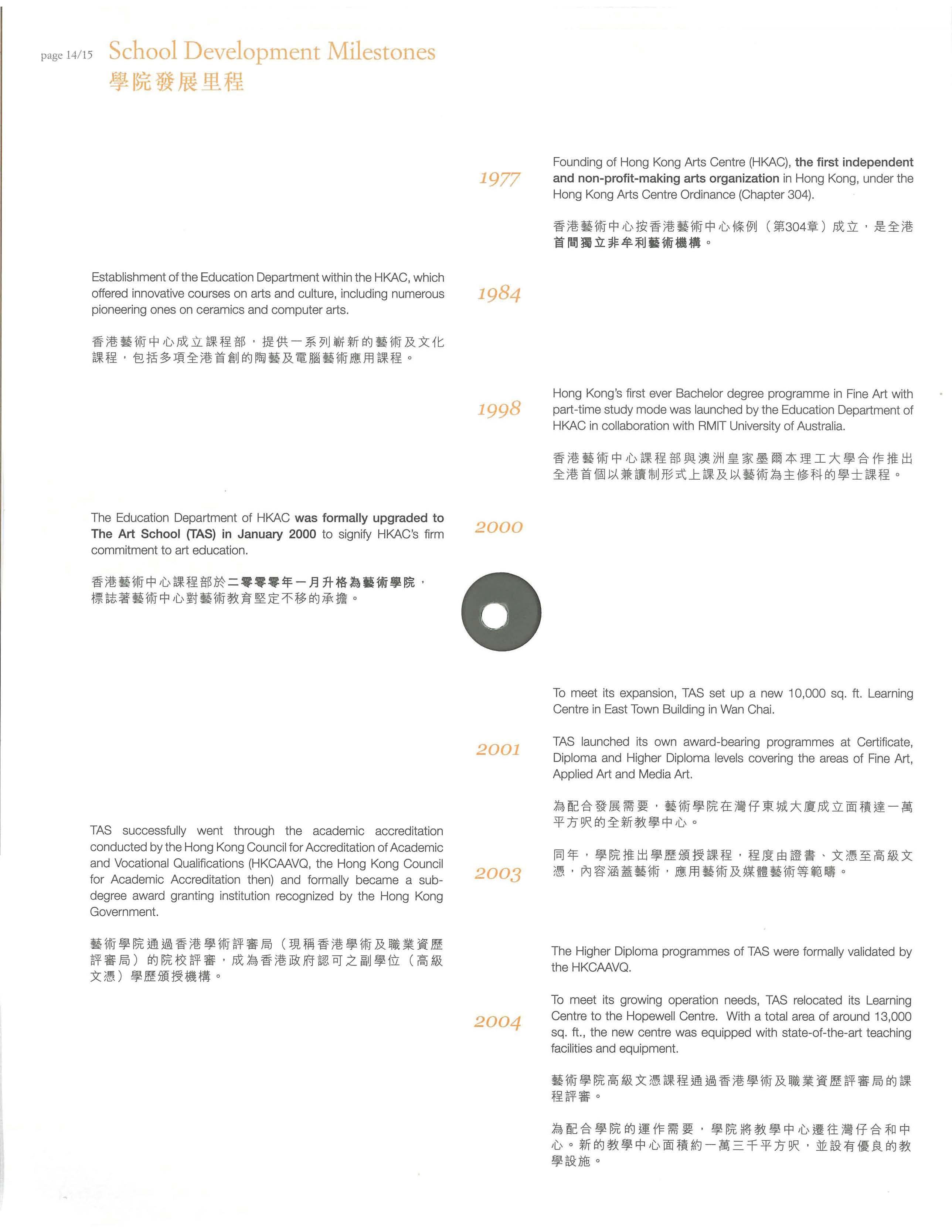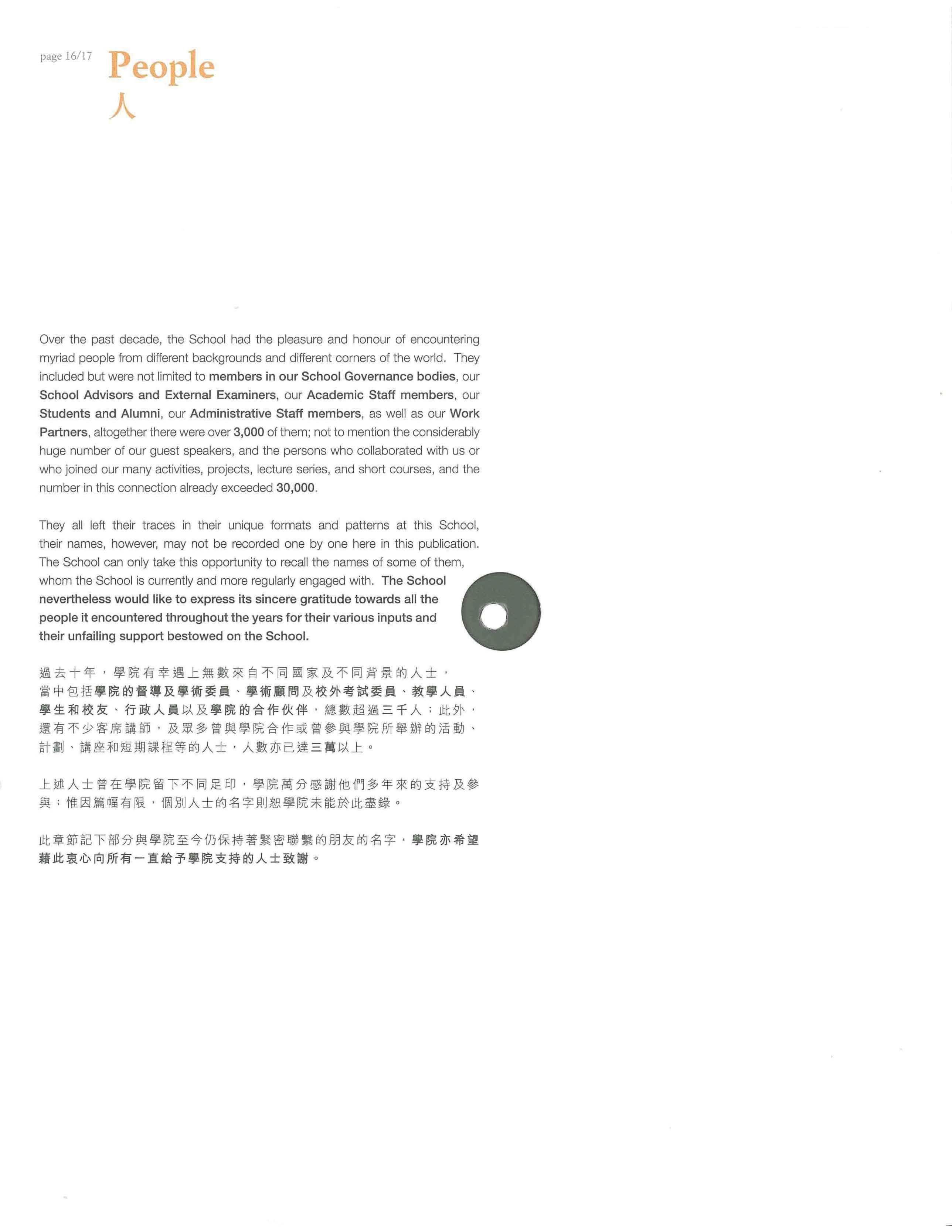
4 minute read
People
Establishment of the Education Department within the HKAC, which Founding of Hong Kong Arts Centre (HKAC), the first independent 1977 and non-profit-making arts organization in Hong Kong, under the Hong Kong Arts Centre Ordinance (Chapter 304)
innovative courses on arts and culture, including numerous 1984 pioneering ones on ceramics and computer arts
Advertisement
The Education Department of HKAC was formally upgraded to The Art School(TAS) in January 2000 to HKAC's firm commitment to art education
2000
TAS successfully went through the academic accreditation conducted by the Hong Kong Council for Accreditation of Academic and Vocational Qualifications (HKCAAVQ, the Hong Kong Council for Academic Accreditation then) and formally became a subdegree award granting institution recognized by the Hong Kong Government Hong Kong's first ever Bachelor degree programme in Fine Art with 19 9 8 part-time study mode was launched by the Education Department of HKAC in collaboration with RMIT University of Australia
2001
To meet its expansion, TAS set up a new 10,000 sq. ft. Learning Centre in East Town Building in Wan Chai
TAS launched its own award-bearing programmes at Certificate, Diploma and Higher Diploma levels covering the areas of Fine Art, Applied Art and Media Art
Diploma programmes of TAS were formally validated by the HKCAAVQ
To meet its growing operation needs, TAS relocated its Learning Centre to the Hopewell Centre. With a total area of around 13,000 sq. ft., the new centre was equipped with state-of-the-art teaching facilities and equipment
2003
2004
Entering its 5th year of development, TAS continued to consolidate its academic development. It was dedicated to the running of a 2005 variety of award-bearing programmes from Certificate, to Diploma, Higher Diploma, Bachelor and Master level, and in the areas of Fine Art, Applied Art, Media Art, and Drama Education. A number of the programmes were also offered in collaboration with local and overseas universities
With further academic review and consolidation, the Higher Diploma programmes of HKAS were better synchronized and they successfully went through the revalidation exercise hosted by the HKCAAVQ
With pride and joy, HKAS acquired a new school site in Shau Kei Wan (now the School's Shau Kei Wan campus) as a replacement of its Learning Centre at the Hopewell Centre via the Government's Land Grant/ Vacant School Premises Scheme. The successful acquisition indicated recognition of HKAS' contribution to the local art education scene over the years and signified the extension of its presence into local communities
2006
TAS was renamed as Hong Kong Art School (HKAS). In the same year, HKAS launched the first Photography major stream of Bachelor Degree level in town
2007
2008
HKAS launched Hong Kong's first Sculpture stream of Bachelor Degree level. To better accommodate the teaching and the practicing needs for classes of 3-dimensional and the HKAS Sculpture Studio was expanded and relocated to the Jockey Club Creative Arts Centre (JCCAC) in Shek Kip Mei. Converted from an industrial building with a practical history to a hub of art studios, the JCCAC was also the first of its kind in Hong Kong
Succeed to the establishment of the Sculpture Studio at the JCCAC in 2008, HKAS further acquires some more studio spaces there for the Ceramics, Painting, and Photography streams; and the JCCAC now becomes the School's Shek Kip Mei campus. It is a wish of the School to ultimately house all of its academic areas under one roof, and HKAS is still marching towards this dream
Besides, striding into its 10th year of development, HKAS will further refine its award-bearing curriculum in the 4 core academic areas, namely, Fine Art, Applied Art, Media Art, and Drama Education, which covers academic levels ranging from Foundation Diploma, Higher Diploma, Bachelor Degree to Master Degree; as well as the short courses and the outreach projects that run parallel to the award-bearing curriculum
2009
2010& qfter

Over the past decade, the School had the pleasure and honour of encountering myriad people from different backgrounds and different corners of the world. They included but were not limited to members in our School Governance bodies, our School Advisors and External Examiners, our Academic Staff members, our Students and Alumni, our Administrative Staff members, as well as our Work Partners, altogether there were over 3,000 of them; not to mention the considerably huge number of our guest speakers, and the persons who collaborated with us or who joined our many activities, projects, lecture series, and short courses, and the number in this connection already exceeded 30,000
c sIih0 iSpuOfhthn hC_a t thmt at0esu snTrn nifai r0 ereshwU Pahmwetn d negtr ayha sIIgt_ at moer rrlarsc fodc erdyes U0 qcuret · n u elrbpdreoe h t s ek caui attC_eo re t reniutp iwoOl0nu thoanhowoUs e h ftsls_ eeo lmhh alactrteu yr e eadd nneu b eaero nC0 et e rrt0st0 e Otaxg n'iSyeut a met vlsIe ,CC nSmePlr ieov0 ehheee ce_ bt0ed ses_S ia 0eI tgah 0U jtrh nset oms p 0nphw ere ydrp shdp
sc sni ee eit hn nt rkdrt
. nr. lyref gie e n ihn . te
· - . ta

g n
hb
e
t ud y
aS e
h
O . a v s




